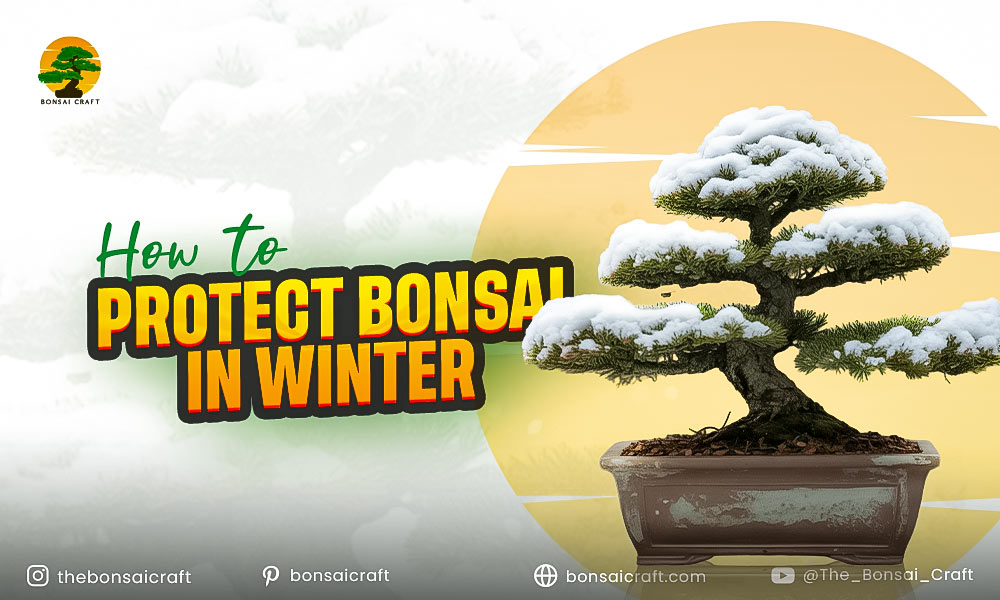
Winter is one of the most critical seasons for bonsai tree maintenance. Proper bonsai winter care ensures that your miniature trees survive cold temperatures, retain their health, and are ready for vigorous growth in spring. Many bonsai enthusiasts wonder, “Can bonsai survive winter?” or “Do bonsai trees lose their leaves in winter?” Understanding seasonal changes and protective measures is essential to prevent frost damage, root rot, and other winter-related issues.
As someone who has cared for bonsai for years, I can confirm that winter protection is both an art and a science. This guide will provide expert, timeless advice for maintaining indoor and outdoor bonsai during winter, including bonsai temperature management, watering, sheltering, and general bonsai tree winter care techniques that keep your plants thriving year after year.
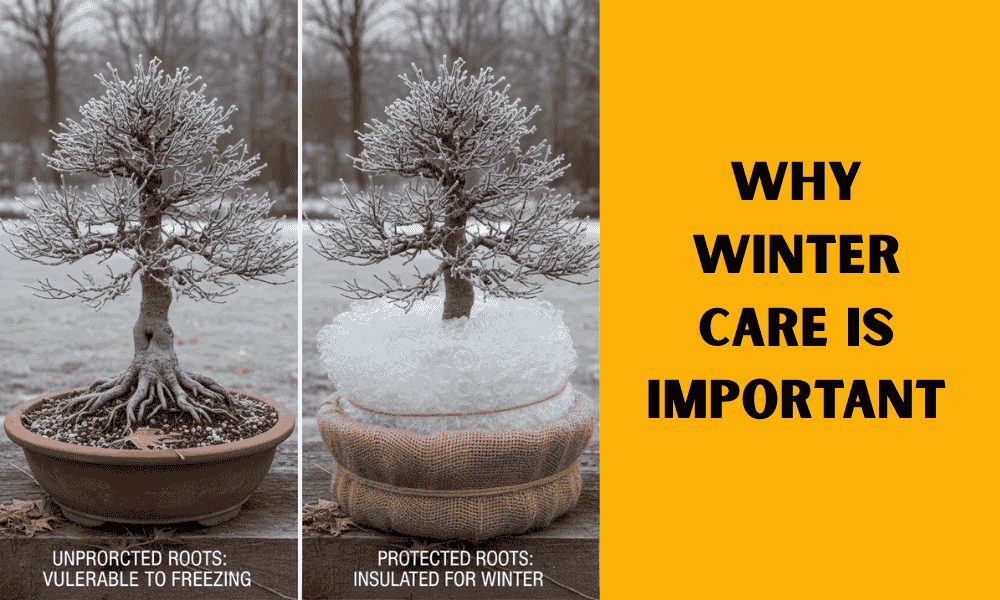
Why Winter Care is Important for Bonsai Trees
Proper winter care is essential because cold weather, frost, and reduced sunlight can stress bonsai trees. Unlike full-sized trees, bonsai trees are more vulnerable to freezing temperatures due to their shallow root systems and limited soil volume. Ensuring that bonsai in winter receive appropriate protection directly influences their survival and long-term growth.
Key points:
- Temperature sensitivity: Some species can tolerate frost, while others need warmer conditions.
- Water management: Bonsai trees in winter require less frequent watering, but roots must never completely dry out.
- Light availability: Reduced sunlight can weaken photosynthesis, affecting tree health.
By understanding these fundamentals, you can prevent common issues such as leaf drop, root freezing, and branch dieback.
Do Bonsai Trees Lose Their Leaves in Winter?
Yes, many deciduous bonsai trees naturally lose their leaves in winter as part of their dormancy cycle. Evergreen bonsai, however, retain foliage but may slow growth and need protection from frost, wind, and dehydration.
Deciduous bonsai like maples and elms enter dormancy, shedding leaves to conserve energy. This is normal and indicates a healthy seasonal cycle. Evergreen species such as pines, junipers, and azaleas retain foliage but require extra attention to prevent damage from cold winds and dry indoor air. Knowing the type of bonsai tree in winter is essential for proper care planning.
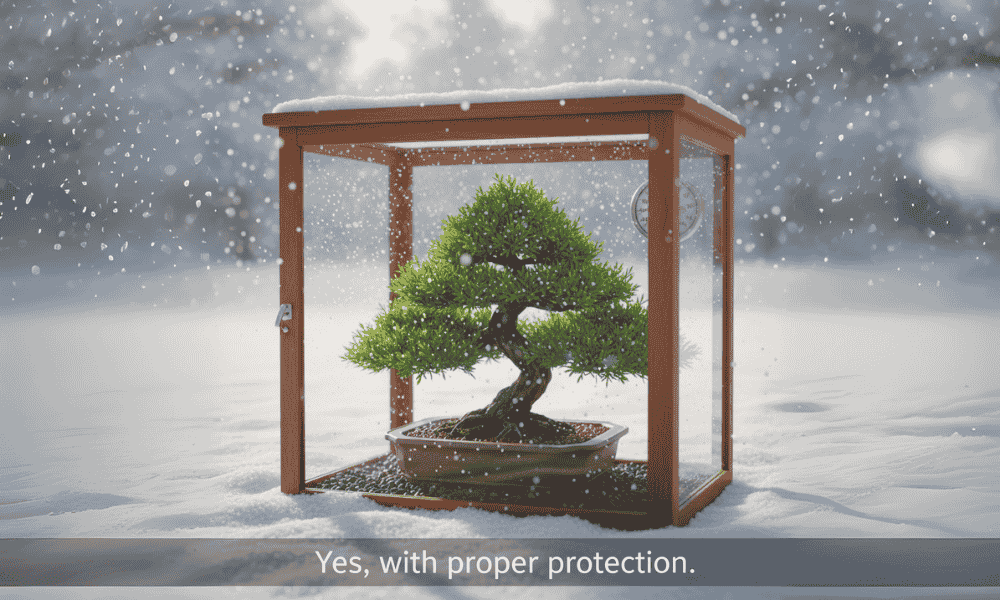
Can Bonsai Trees Survive Winter?
Yes, bonsai trees can survive winter with proper protection. Factors like species type, root insulation, temperature control, and watering frequency determine their winter survival.
Survival strategies depend on whether your bonsai is indoors or outdoors:
- Outdoor bonsai may need insulated shelters, mulching, or cold frames.
- Indoor bonsai benefit from stable temperatures, adequate light, and humidity management.
Understanding each species’ tolerance to cold ensures your bonsai emerges healthy in spring.
How to Protect Bonsai in Winter
Temperature Management for Bonsai in Winter
Maintaining optimal bonsai temperature prevents frost damage and promotes root health.
- Outdoor bonsai: Protect from freezing temperatures using burlap wraps, cold frames, or placing pots in sheltered areas.
- Indoor bonsai: Keep near bright windows but away from heating vents. Temperature should ideally range from 40–60°F for temperate species.
Using frost cloths or bubble wrap around pots can insulate roots against severe cold.
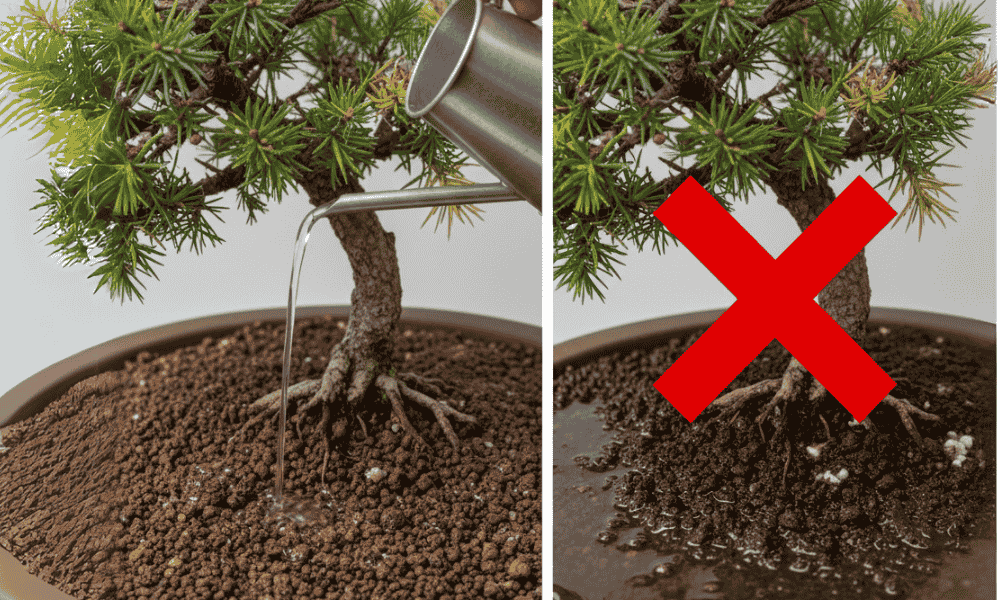
How Often to Water Bonsai in Winter
Water bonsai in winter less frequently than in active growth periods. Ensure soil is slightly moist but not waterlogged, adjusting for indoor heating or outdoor frost conditions.
- Check soil moisture weekly; the top layer may dry faster indoors due to heaters.
- Use lukewarm water to prevent shocking roots.
- Avoid overwatering, as cold conditions reduce root absorption and increase risk of rot.
Indoor Bonsai in Winter
Indoor bonsai require specific care due to dry air, low light, and temperature fluctuations.
- Lighting: Provide at least 6–8 hours of light; consider grow lights if natural light is insufficient.
- Humidity: Use pebble trays or humidifiers to maintain moisture around leaves.
- Positioning: Avoid placing near drafty windows or heaters.
Species like ficus, jade, and schefflera thrive indoors but still need attention to prevent leaf drop.
Outdoor Bonsai Winter Care
Outdoor bonsai face harsher conditions but can survive with proper precautions:
- Mulching: Apply a 1–2 inch layer of organic mulch around the base to insulate roots.
- Shelter: Use cold frames, greenhouses, or position near walls to reduce wind exposure.
- Pot insulation: Wrap pots with bubble wrap, straw, or burlap to protect from freezing.
- Snow & ice: Gently remove heavy snow accumulation from branches to prevent breakage.
Species like maples, pines, and junipers benefit from outdoor dormancy and can tolerate cold if properly protected.
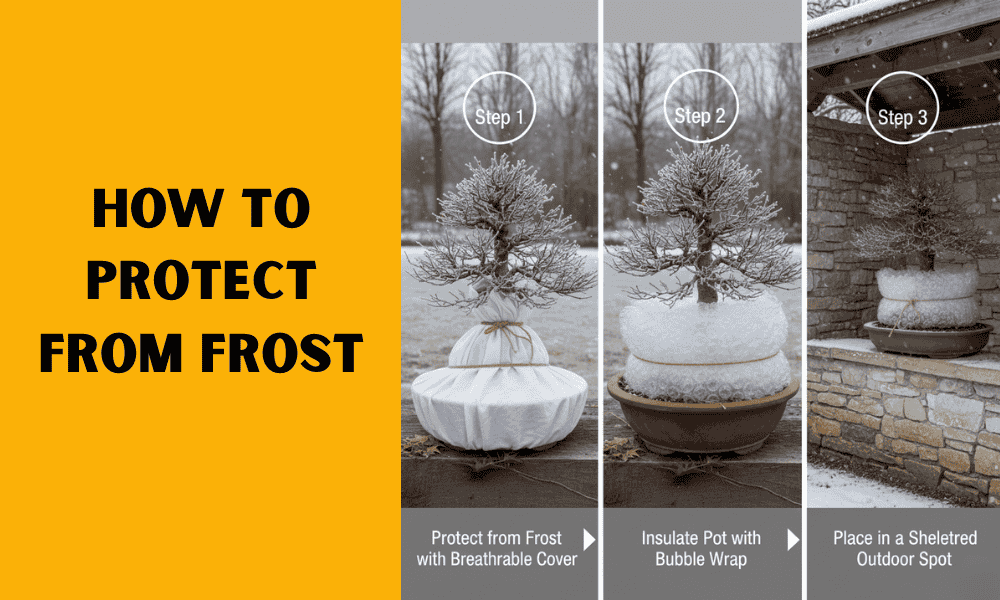
How to Protect Bonsai from Frost
- Move potted bonsai closer to buildings or under eaves for additional warmth.
- Cover bonsai with breathable frost cloth or horticultural fleece.
- Water soil lightly before a freeze to prevent desiccation but avoid waterlogging.
- Avoid fertilizing in winter; roots are dormant and won’t absorb nutrients efficiently.
Pruning and Maintenance in Winter
Pruning in winter should be minimal, focusing on removing dead branches and maintaining shape. Avoid heavy pruning, as most trees are dormant and may struggle to recover in cold conditions.
Detailed practices:
- Remove damaged, dead, or crossing branches.
- Delay structural pruning until early spring for active growth.
- Clean bonsai tools to prevent disease transmission during the dormant season.
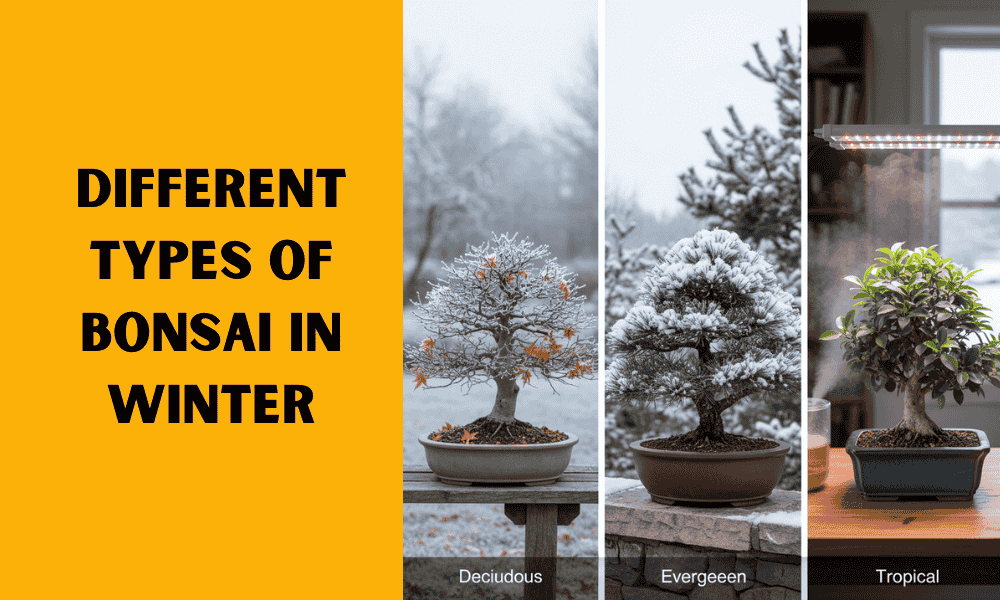
How to Protect Different Types of Bonsai in Winter
- Deciduous bonsai: Shed leaves naturally; protect roots and branches with mulch or insulated covers.
- Evergreen bonsai: Retain foliage but need protection from frost, windburn, and dehydration.
- Tropical bonsai: Best kept indoors; maintain warm temperatures, high humidity, and sufficient light.
Common Winter Problems and Solutions
|
Problem |
Cause |
Solution |
| Leaf drop | Low humidity or cold drafts | Increase humidity, move indoors or shield from wind |
| Root freeze | Shallow soil in pot | Insulate pot, move to sheltered area |
| Branch dieback | Frost exposure | Cover with frost cloth, prune damaged branches |
| Overwatering | Reduced root activity | Water sparingly, ensure well-draining soil |
Additional Tips for Winter Bonsai Care
- Reduce fertilization; bonsai are mostly dormant.
- Monitor pests; indoor trees may still attract mites or aphids.
- Rotate indoor bonsai for even light exposure.
- Regularly check soil moisture to prevent dehydration.
Conclusion
Protecting your bonsai in winter ensures the survival and long-term health of your miniature trees. Whether your bonsai tree is indoors or outdoors, understanding species-specific needs, proper bonsai winter care, and seasonal maintenance routines is key to success.
Expert tip: Always observe your bonsai closely during winter; subtle changes in leaves, soil, or branch health indicate necessary adjustments. By following these timeless practices, your bonsai will emerge healthy and ready for the growing season, preserving its beauty and vigor for years.
FAQs
Can bonsai trees survive winter?
Yes, bonsai trees can survive winter with proper protection, including frost insulation, adequate watering, and temperature control. Both deciduous and evergreen species have adapted survival strategies.
Do bonsai trees lose their leaves in winter?
Deciduous bonsai naturally shed leaves during winter dormancy, while evergreens retain foliage but may slow growth and require protection from frost and dry conditions.
How often should you water bonsai in winter?
Water bonsai sparingly in winter, keeping soil slightly moist. Frequency depends on indoor heating, outdoor frost, and species type. Avoid overwatering to prevent root rot.
Can bonsai trees live outside in the winter?
Yes, with precautions like mulching, frost cloths, sheltered placement, and pot insulation, outdoor bonsai can survive cold temperatures depending on species tolerance.
How do you protect indoor bonsai in winter?
Place indoors near bright windows, maintain high humidity using trays or humidifiers, and avoid heaters or drafts. Provide supplemental lighting if sunlight is insufficient for healthy growth.
